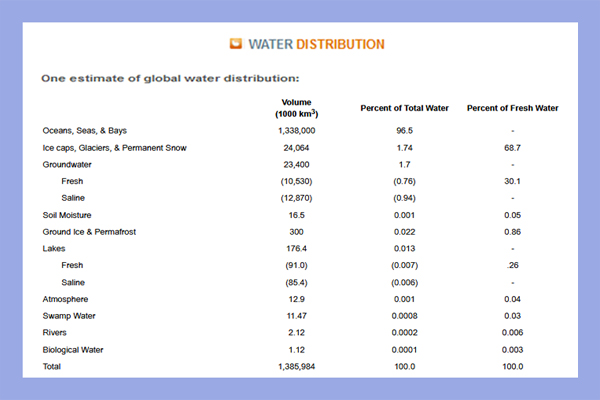Education
The Water Cycle
As seen from space, one of the most unique features of our home planet is the water, in both liquid and frozen forms, that covers approximately 75% of the Earth's surface. Believed to have initially arrived on the surface through the emissions of ancient volcanoes, geologic evidence suggests that large amounts of water have likely flowed on Earth for the past 3.8 billion years, most of its existence. As a vital substance that sets the Earth apart from the rest of the planets in our solar system, water is a necessary ingredient for the development and nourishment of life.
WATER IS A NECESSARY INGREDIENT FOR THE DEVELOPMENT
AND NOURISHMENT OF LIFE
Image Source: Gleick, P. H., 1996: Water resources. In Encyclopedia of Climate and Weather, ed. by S. H. Schneider, Oxford University Press, New York, vol. 2, pp.817-823.
Estimates of groundwater are particularly difficult and vary widely amongst sources, with the value in this table being near the high end of the range. Using the values in this table, groundwater constitutes approximately 30% of fresh water, whereas ice (including ice caps, glaciers, permanent snow, ground ice, and permafrost) constitute approximately 70% of fresh water. With other estimates, groundwater is sometimes listed as 22% and ice as 78% of fresh water.
Note: Click on the image for bigger picture.
Water, Water, Everywhere
Water is everywhere on Earth and is the only known substance that can naturally exist as a gas, liquid, and solid within the relatively small range of air temperatures and pressures found at the Earth's surface. In all, the Earth's water content is about 1.39 billion cubic kilometers (331 million cubic miles) and the vast bulk of it, about 96.5%, is in the global oceans. Approximately 1.7% is stored in the polar icecaps, glaciers, and permanent snow, and another 1.7% is stored in groundwater, lakes, rivers, streams, and soil. Finally, a thousandth of 1% exists as water vapor in the Earth's atmosphere.
WATER IS A NECESSARY INGREDIENT FOR THE DEVELOPMENT AND NOURISHMENT OF LIFE
Related Links:
 The Hydrologic Cycle - A Multi-Phased Journey
The Hydrologic Cycle - A Multi-Phased Journey
Browse Quotes and Proverbs...
Cool Quotes Vol. 1
If silence is golden, then speech is platinum...
Cool Quotes Vol. 2
If you are too careful, you are so occupied in being...
Cool Quotes Vol. 3
The only time to eat DIET FOOD is while you're waiting...
Wise Old Sayings
One today is worth two tomorrows...

Education
Discover where the capital of the United States has been located...Did You Know?
Of the various components that are found in the human body, water occurs in the largest quantity. As a food substance, it is an extremely important feature of a person's diet. Its chief purpose is to replenish the liquids of the body and to assist in the digestion of food.
Although nature provides considerable amounts of water in most foods, large quantities must be taken in the diet as a beverage. In fact, it is the need of the body for water that has led to the development of numerous beverages. Besides being necessary in building up the body and keeping it in a healthy condition, water has a special function to perform in food preparation and cooking.
Ranking next to water in the quantity contained in the human body is mineral matter. This constituent, which is also called ash or mineral salts, forms the main part of the body's framework, or skeleton.
In the building and maintaining of the body, mineral salts serve three purposes--to give rigidity and permanence to the skeleton, to form an essential element of active tissue, and to provide the required alkalinity or acidity for the digestive juices and other secretions.
Plants in their growth seize from the earth the salts of minerals and combine them with other substances that make up their living tissue. Then human beings, as well as other living creatures, get their supply of these needed salts from the plants that they take as food, this being the only form in which the salts can be thoroughly assimilated.






